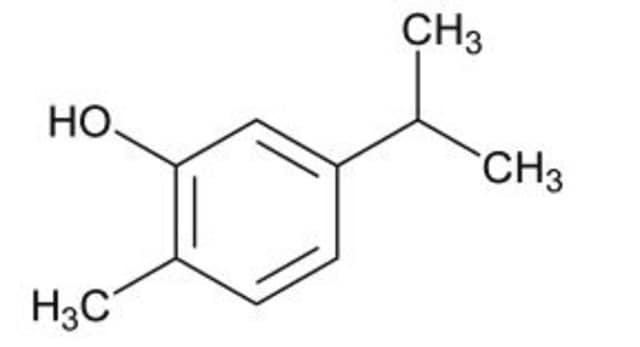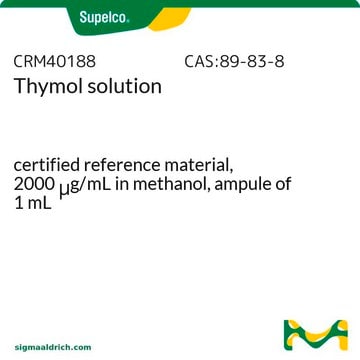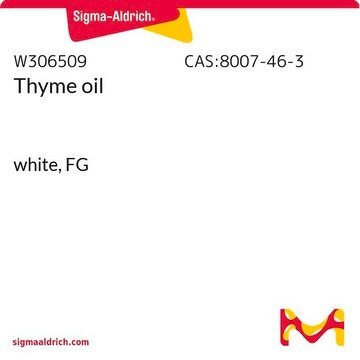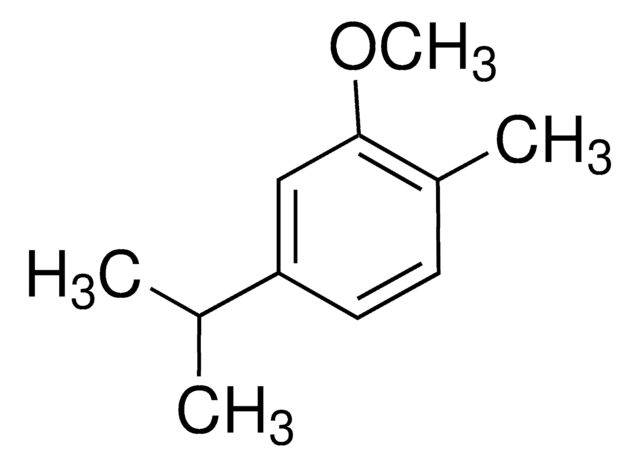W224502
Carvacrol
≥98%, FCC, FG
Synonym(s):
5-Isopropyl-2-methylphenol
About This Item
Recommended Products
biological source
synthetic
Quality Level
grade
FG
Fragrance grade
Halal
Kosher
Agency
follows IFRA guidelines
meets purity specifications of JECFA
reg. compliance
EU Regulation 1223/2009
EU Regulation 1334/2008 & 178/2002
FCC
FDA 21 CFR 117
FDA 21 CFR 172.515
Assay
≥98%
refractive index
n20/D 1.522 (lit.)
bp
236-237 °C (lit.)
mp
3-4 °C (lit.)
density
0.976 g/mL at 20 °C (lit.)
application(s)
flavors and fragrances
Documentation
see Safety & Documentation for available documents
food allergen
no known allergens
fragrance allergen
no known allergens
Organoleptic
camphoraceous; woody; spicy
SMILES string
CC(C)c1ccc(C)c(O)c1
InChI
1S/C10H14O/c1-7(2)9-5-4-8(3)10(11)6-9/h4-7,11H,1-3H3
InChI key
RECUKUPTGUEGMW-UHFFFAOYSA-N
Gene Information
human ... UGT1A4(54657)
Looking for similar products? Visit Product Comparison Guide
General description
Application
- Carvacrol and Thymol Hybrids: Potential Anticancer and Antibacterial Therapeutics.: This review explores the synthesis, characterization, and biological activities of carvacrol and thymol hybrids, highlighting their potential as anticancer and antibacterial agents. The study emphasizes the significance of these compounds in developing novel therapeutic strategies (Peter et al., 2024).
- Essential Oil Constituents as Anti-Inflammatory and Neuroprotective Agents: An Insight through Microglia Modulation.: This review investigates the role of essential oil constituents, including carvacrol, in modulating microglial activity. The findings suggest significant anti-inflammatory and neuroprotective effects, providing insights into their potential therapeutic applications in neuroinflammatory diseases (Stojanović et al., 2024).
- Evidence of the Protective Role of Carvacrol in a Retinal Degeneration Animal Model.: This study demonstrates the protective effects of carvacrol in a retinal degeneration model. The results indicate that carvacrol can mitigate retinal damage and preserve retinal function, suggesting its potential as a therapeutic agent for retinal diseases (Inda et al., 2024).
Disclaimer
Signal Word
Danger
Hazard Statements
Precautionary Statements
Hazard Classifications
Acute Tox. 4 Oral - Aquatic Chronic 2 - Eye Dam. 1 - Skin Corr. 1B
Storage Class Code
8A - Combustible corrosive hazardous materials
WGK
WGK 3
Flash Point(F)
>212.0 °F
Flash Point(C)
> 100 °C
Personal Protective Equipment
Certificates of Analysis (COA)
Search for Certificates of Analysis (COA) by entering the products Lot/Batch Number. Lot and Batch Numbers can be found on a product’s label following the words ‘Lot’ or ‘Batch’.
Already Own This Product?
Find documentation for the products that you have recently purchased in the Document Library.
Customers Also Viewed
Our team of scientists has experience in all areas of research including Life Science, Material Science, Chemical Synthesis, Chromatography, Analytical and many others.
Contact Technical Service












